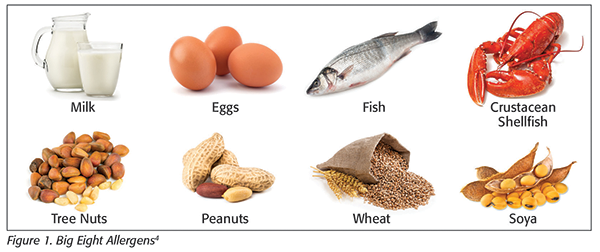The U.S. Centers for Disease Control and Prevention estimates that about 15 million Americans are affected by food allergies, and allergic reactions are responsible for 30,000 emergency room visits every year.[1] Approximately 4 in every 100 American children have a food allergy.[2]
An allergic reaction happens when a food-allergic person’s immune system recognizes proteins in certain foods and causes the body to react in ways that can be quite damaging, even life threatening. Many reactions are caused when a food-allergic person eats a nonallergenic food that has come into contact, directly or indirectly, with an allergen.
There is also the autoimmune disorder celiac disease. According to the U.S. Department of Health and Human Services,3 celiac disease affects about 1 percent of Americans—roughly the population of Connecticut. Although celiac disease can manifest itself in many ways (including damage to nearly every major organ system), all patients experience one common symptom: destruction of the interior lining of the intestines by the body’s own immune system. The only treatment for celiac disease is to avoid gluten, a protein structure found in wheat, barley, and rye.
Major Food Allergens
 The U.S. Food and Drug Administration lists eight common food items that cause 90 percent of food-allergic reactions in the U.S.: milk, eggs, fish, crustacean shellfish, tree nuts, peanuts, wheat, and soybeans (Figure 1[4]). These food items are known as the “major food allergens,” or “Big Eight.” Allergic reactions have also been connected to various fruits, spices, food additives like sulfites and monosodium glutamate, and other common ingredients like molluscan shellfish, corn, seeds, and gelatin.
The U.S. Food and Drug Administration lists eight common food items that cause 90 percent of food-allergic reactions in the U.S.: milk, eggs, fish, crustacean shellfish, tree nuts, peanuts, wheat, and soybeans (Figure 1[4]). These food items are known as the “major food allergens,” or “Big Eight.” Allergic reactions have also been connected to various fruits, spices, food additives like sulfites and monosodium glutamate, and other common ingredients like molluscan shellfish, corn, seeds, and gelatin.
Controlling Allergens on the Production Line
Food manufacturers must evaluate their operations to recognize and develop plans to control allergens. All aspects of a manufacturing operation must be evaluated to ensure that Critical Control Points have been identified. Evaluation for allergen hazards (a chemical hazard) should be part of the company’s Hazard Analysis and Critical Control Points plan. Additionally, the following steps are essential to control cross-contamination with allergens:
• Train your team. Teach employees about the major food allergens and where they are found in your operation. Training personnel from management and researchers to line production employees will help ensure that risks associated with allergens are fully understood.
• Monitor your processes. It is important to have an ongoing monitoring system to verify that all Critical Control Points are being consistently met. Dedicate production systems to handle only allergen or nonallergen products.
• Redesign the product flow. Ensure that allergenic ingredients are added at the end of a production line, limiting equipment exposure. Design production lines to isolate allergen-addition points, dedicate refeed systems, ensure product containment, and eliminate crossover of conveyor lines.
• Design and install equipment for easier cleaning, inspection, and maintenance. Improved design enhances cleanability, decreasing the risk of allergen cross-contamination.
• Use separate or recently cleaned and sanitized equipment. Did you know that your normal cleaning and sanitizing processes can remove food allergen proteins?[5] An even better practice is to maintain separate surfaces and items specifically for allergen-free food preparation.
Implementing an allergen control plan in your food processing plant is essential to avoid allergen cross-contamination and potentially damaging recalls and adverse or even fatal physiological reactions in consumers.
Conclusion
The number of people with food allergies continues to grow, presenting both a challenge and an opportunity for food manufacturers. Using reliable test kits to accurately detect potential allergen contamination has become a critical necessity for food producers. The increased availability of food allergen test kits allows the reliable detection of allergens in food products, helping safeguard the food supply.
Food Safety Magazine thanks Emilee Follett, CP-FS, CCFS, from StateFoodSafety for her expertise.
References
1. www.cdc.gov/mmwr/volumes/66/wr/mm6615a2.htm.
2. www.cdc.gov/nchs/products/databriefs/db10.htm.
3. www.niddk.nih.gov/health-information/digestive-diseases/celiac-disease.
4. farrp.unl.edu/informallbig8.
5. www.hopkinsmedicine.org/Press_releases/2004/05_08b_04.html.




